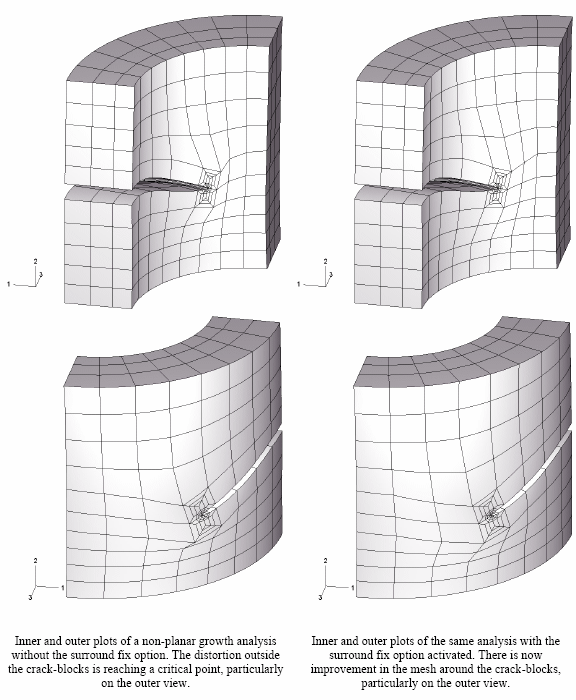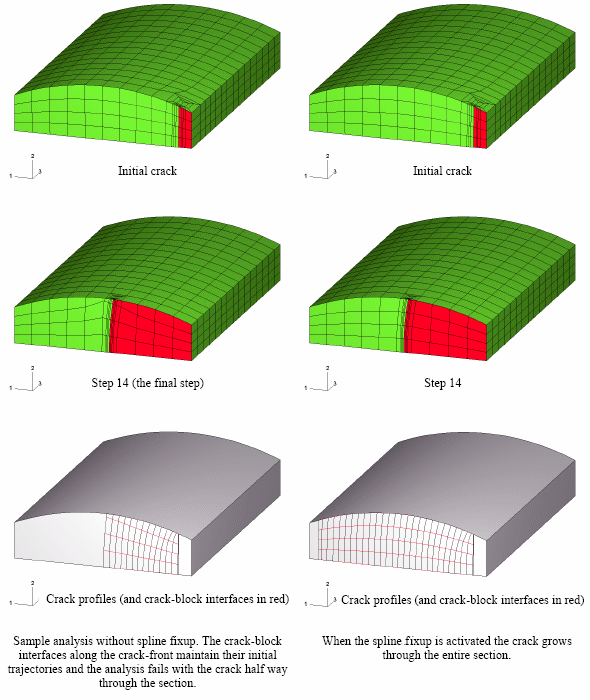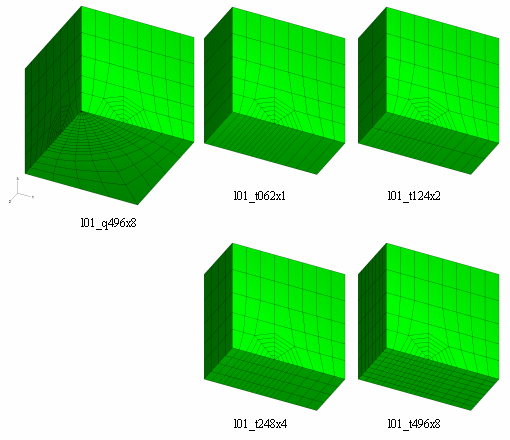- Software
- Zencrack
- What’s New in Zencrack?
Zencrack 7.4
What's New in Zencrack?
Zencrack 7.4
Zencrack version 7.4 was finalised on 10 August 2005
This release includes an interface to the Finas finite element code.
General enhancements
- The restriction on model sizes that existed in previous versions of Zencrack has been removed. The only limits on the number of nodes and elements are now due to available memory and formatting restrictions.
- The upper limit of 500 split element pairs in a split set has been removed. There is no longer any upper limit on the number of split pairs in a split set subject to available memory.
- The maximum number of load systems used to define a load spectrum has been increased from 40 to 80.
- A number of algorithms have been improved to provide performance enhancements. This is most noticeable on large jobs with highly irregular / non-consecutive node and element numbers and jobs with a large number of elements in the relax element list.
- A new algorithm for fixing up the elements surrounding the crack blocks has been developed to help reduce element distortion. The algorithm is activated on the SURROUND FIX option on the *BOUNDARY SHIFT keyword. An example of the reduction in element distortion from this option is seen here.

- It is now possible to distribute the crack front nodes evenly along the
crack front. This is done with the SPLINE FIXUP parameter on the *CRACK FRONT keyword. An example of the benefit of this algorithm is shown here.

- The algorithm that controls transfer of crack-blocks to a new location when boundary shifting is set to TYPE=transfer has been modified. Previously the crack front would transfer as soon as any of the crack-blocks on the crack front met the transfer criteria. Now at least half of the crack-blocks must meet the transfer criteria before the transfer takes place. This is beneficial in producing better meshes for crack fronts that develop faster at one end than the other.
- A change has been made in the checks for inside-out elements in the cracked mesh. Previously Zencrack would stop before generating the cracked mesh if any inside-out elements were found at the end of the relaxation algorithm. This made it difficult to see where the problems were located in the mesh. The new procedure is that Zencrack always checks for inside-out elements before writing the cracked mesh. If any are found, a message is generated in the .rep file. The analysis progresses, however, in order that the cracked mesh can be assessed in a pre/post-processor. The analysis will stop at the f.e. pre-processing stage due to the inside-out elements.
- The number of element rings around the crack front and the numbers of contours that can be evaluated are now independent items. This allows more control over crack-blocks that have some special requirements in terms of the element rings.
- The number of contour rings that can be processed has been increased to accommodate the largest available crack-blocks. Previously only eight contours could be processed even if the crack-blocks could allow calculation of more than eight values.
- The direction for crack growth prediction that is calculated from stress intensity factors now uses the maximum tangential stress criterion rather than the inverse tangent criteria that was used in previous releases.
- The direction for crack growth can be specified as based on energy or displacement based results, independently of the method used for calculating the magnitude of crack growth.
- It is now possible to run all the supplied demo examples using the evaluation version of Zencrack.
- A capability is added to allow remote execution of the finite element code on a Unix machine when Zencrack is installed on a Windows machine. This differs from the normal setup in which Zencrack and the finite element code are executed on the same machine.
- If the output filename for a job is not specified in the input file, a default string is added to the zcr filename. This string can now be defined by the user.
Crack-block library
- The crack-block library has been revised to group crack-blocks into "families". This has meant that crack-blocks have been renamed. Existing job files will automatically switch to the new crack-block names with a warning generated in the .rep file.
- In addition to the use of families, three of the old crack-blocks have been removed and eight new crack-blocks are provided.
- The switch to this family based approach allows straightforward addition to the library in the future.

Abaqus interface
- The handling of element and node sets has been significantly
improved to allow use of set names in defining boundary conditions,
loads and surfaces. If set names are used on the relevant Abaqus
keywords, Zencrack checks the contents of the sets to identify any nodes
or elements that are related to replaced elements. Appropriate action
is then taken to ensure the cracked mesh contains correctly updated data
for the crack-blocks. This reduces the manual effort in preparing the
uncracked mesh.
- Boundary conditions can be applied in the crack region using node sets on *BOUNDARY.
- Temperatures can be specified or initialised in the crack region using node sets on *TEMPERATURE and *INITIAL CONDITIONS, TYPE=TEMPERATURE.
- Element sets can be used for defining pressure loading on the faces of crack-blocks on *DLOAD.
- Element sets can be used for surface definitions on the outer surfaces of crack-blocks on *SURFACE, TYPE=ELEMENT. One consequence of this change is that it is now much easier to apply surface based loading using *DSLOAD.
- Every *BOUNDARY option is processed independently for possible updates. Previously only the *BOUNDARY options in the first step were processed.
- Degrees of freedom 1-16 and special types XSYMM, YSYMM, ZSYMM, XASYMM, YASYMM, ZASYMM, ENCASTRE, PINNED on *BOUNDARY are now handled for possible updates in the crack region. Previously only constraints on degrees of freedom 1, 2 or 3 could be updated by Zencrack.
- The update of the Abaqus *SURFACE option for crack faces and the use
of the Zencrack CONTACT keyword have been modified to give increased
functionality:
- If a *SURFACE update is for a crack face region, the generated surface is a pure element based surface. Previously the crack face side 2 surfaces would have been mixed element and node based surfaces.
- The CONTACT keyword has a new TYPE parameter with options "contact" and "surface". The contact option introduces crack face surfaces and contact definitions. The surface option generates crack face surfaces only. In 20 noded meshes the surfaces generated with these options will be pure element based on one side of the crack front and element and node based for the other side.
- The CONTACT keyword has a new parameter SLAVE that allows specification of whether side 1 or side 2 of the crack front is the slave surface in the crack face contact pair.
- New parameters K FACTORS and T-STRESS are available on the *ENERGY RELEASE RATE keyword. These options insert additional contour integral requests for K values and T-stresses into the cracked mesh. The results of these evaluations are not currently processed by Zencrack but are available in the Abaqus .dat files for review or manual processing.
- The Abaqus keyword file keyabq.dat is updated for versions up to Abaqus 6.5-1.
Ansys interface
- Every group of consecutive D options is treated as a single independent block for possible updates.
- Degrees of freedom XROT, YROT, ZROT and TEMP on D options are now handled for updates in addition to UX, UY, UZ, ALL.
- The file type .out is added to the possible Ansys files that can be saved via the *SAVE option.
- The Ansys keyword file keyans.dat is updated for versions up to Ansys 9.0.
Finas interface
- This is a new interface in this release.
Marc interface
- All DIST LOADS options before and after END OPTION are now considered for updating by Zencrack. Previously only the DIST LOADS options before END OPTION could be updated.
- Every FIXED DISP model definition option is now processed independently for possible updates.
- Every DISP CHANGE history option is now processed independently for possible updates.
- The interpolation of nodal temperatures into the crack-blocks from the values in the uncracked mesh is now available in the Marc interface. Temperature distributions on the following options can be updated: FIXED TEMPERATURE, INITIAL TEMP, POINT TEMP and TEMP CHANGE.